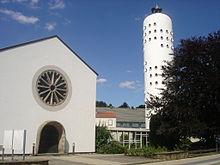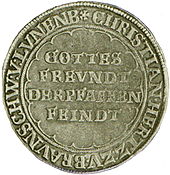Holy Spirit Church (Braunschweig)
The Holy Spirit Church is the Catholic parish church in Braunschweig-Lehndorf , its parish belongs to the Braunschweig deanery of the Hildesheim diocese . The building from 1952 is remarkable for its architecture and furnishings.
prehistory
The Lower Saxony area and with it Braunschweig had become a diaspora for Christians of Catholic denomination due to the lasting effect of the rule Cuius regio, eius religio, a past determined by sovereign princes .
After a large number of Catholics had settled in Braunschweig again, the St. Godehard Vicarie was built in Lehndorf in 1942 or 1943 , to which around 1,000 Catholics belonged at the beginning. A room for church services was initially not available, but the establishment of the vicariate saved the priest responsible for this from being drafted into the armed forces . After the loss of the German eastern territories and the accompanying expulsion of the German population there, the proportion of Catholics in Braunschweig also skyrocketed. A direct aftermath of this is also the construction of the Roman Catholic Holy Spirit Church.
The Catholic parish in Lehndorf, first named after St. Godehard and a branch parish of the St. Josefs parish in Goslarschen Strasse, celebrated its holy masses first in private living rooms and then in the Evangelical Lutheran Alt-Lehndorfer Kreuzkirche , the the local ev.-luth. Parishioners who were already practicing the spirit of ecumenism , which only later became popular , willingly made them available. At that time, pastoral care for 2,000 parishioners had to be guaranteed with the simplest means. All the more urgent became the necessity of own premises, as they were then tackled immediately , supported by the Bonifatiuswerk .
Building the church
In 1952 the foundation stone for the Heilig-Geist-Kirche was laid on the property at St.-Ingbert-Straße 90 by the parish priest at the time, Peter-Paul Urbanczyck (1907–1981). The Brunswick architect Fritz Hauk (1895–1966) took on the design and planning. The layout of the interior is remarkable, as it anticipated the liturgical demands of the 2nd Vatican Council . Dominikus Böhm (Cologne) designed the stained glass, which is well worth seeing. The parish hall and rectory were designed by the Brunswick architect Alfred Geismar . On 14 December 1952 the third Sunday of Advent, which took place the consecration of the church by Bishop Joseph Godehard making . On April 1, 1963, the Heilig-Geist-Gemeinde was raised to an independent parish, since November 1, 2006, the St. Gereon Church in Vechelde and the St. Elisabeth Church in Wendeburg have also belonged to it .
Furnishing
In addition to the tabernacle executed in 1952 and a tree of life monstrance (1961) by Fritz Schwerdt , numerous works in the church are by Toni Zenz , such as the sculptures "Christ and Ekklesia", "The Prayer of St. Antonius", an ambo (lectern) in the form of a Adler, the baptistery, the dove figure on the tower, the altar and a life-size crucifix. Toni Zenz, who stylistically follows the tradition of Ernst Barlach and Käthe Kollwitz , furnished numerous churches in Germany with his sculptures, including St. Bernard in Hamburg - Poppenbüttel and St. Kunibert in Cologne.
The sculpture "Christ and Ekklesia" does not show the cross figuratively, but the crucified in the form of the servant of God, spreading his arms and wrapped and carried by the spirit of God in the symbolic form of the dove. This difficult to access portrait of great expressiveness initially caused a violent dispute in the entire Catholic Church, some of which also related to Pius XII. should be forced, who - abstaining from an art-critical evaluation - should have immediately recognized and appreciated the intention of the picture.
A wood-carved Swabian Madonna figure from the 15th century was acquired later.
The church windows symbolize the three attributes of the Holy Spirit: fire, water and wind. Representing these are represented in geometrically limited shapes: Flames, fish and waves, moving clouds, birds and arrows around the celestial star. Each of the motifs is repeated across the rows of windows in the church in vertical and horizontal groupings and with changing colors and shapes, but in such a way that at the foot of the long window the warm deep red, but above and in the nave, the bright, light colors predominate. The round window framed in sandstone at the front of the church is determined by seemingly random geometric shapes. On Sundays around ten o'clock (peak hour) the window starts to glow in the sunshine and gives the interior a warm color.
In the Heilig-Geist-Kirche there is an organ from the Hildesheim organ building workshop, owner Ernst Palandt from 1958 with 25 stops , mechanical action, two manuals and pedal . Their disposition goes back to the state of the historical organ of St. Mauritius from Hildesheim from 1462, which today no longer exists in this form due to multiple renovations.
Tower and bells
The tower of the Holy Spirit Church was planned and built later than the Holy Spirit Church. The unusual, broken-off cylindrical shape of the tower symbolizes the wounded tree of life, robbed of its crown by sin, but which, through the work of the Spirit of God, is budding. In addition to the baptistery, the tower houses three valuable bells from around 1750, which were cast by various Silesian traveling founders from Opava, Neisse and Gleiwitz and which rang in the All Saints Church in Gleiwitz before the war . In 1943 they came to the Hamburg bell cemetery as melting goods with tens of thousands of other church bells . Since the bells from the eastern regions could not return there after the end of the war, they were then given to newly built churches in western Germany. According to an inventory made a few years ago, this bells ranks second in terms of the vibrating mass in the diocese of Hildesheim after the Hildesheim Cathedral.
Pfaffenfeindtaler
During the Thirty Years' War , Duke Christian von Braunschweig-Wolfenbüttel , who was nicknamed "the great Christian" by the vernacular, had the Paderborn cathedral treasure stolen and struck from the captured silver thalers with the inscription "God's friend, the priest enemy". This mockery coin for Catholic clergy was minted in Soest in 1622. Among other things, the medieval Liborius shrine from Paderborn Cathedral fell victim to the minting of this coin.
The Evangelical Lutheran citizen of Lehndorf, Heinrich Priesmeier, had some of these Pfaffenfeindtaler in his private possession, which he donated to the new Catholic community in Lehndorf in 1961. The thalers were melted down and added to the silver body of the “tree monstrance ” designed and executed by Fritz Schwerdt , one of the thalers was inserted into the monstrance's sight glass and tells of the good outcome of a bad story.
See also
literature
- Eduard Schreuer: Holy Spirit Church 25 years. Festschrift for the 25th anniversary of church building, Braunschweig 1977.
- Bastian Müller: Catholic Church of the Holy Spirit Braunschweig Lehndorf . Benedict Müller Verlag 2012. ISBN 978-3-940131-10-2
Web links
- Heilig-Geist-Kirche on braunschweig.de
- Parish of the Holy Spirit on heilig-geist-braunschweig.de
Individual evidence
- ^ Thomas Flammer: National Socialism and the Catholic Church in the Free State of Braunschweig 1931–1945. Verlag Ferdinand Schöningh, Paderborn 2013, p. 185
- ↑ Müller 2012, 4f
- ↑ Müller 2012, 32
- ↑ Website of the city of Braunschweig , January 19, 2020
- ↑ Bastian Müller, Catholic Church Heilig Geist Braunschweig Lehndorf, self-published Förderverlag Hl. Geist Braunschweig 2012, ISBN 978-3-940131-10-2
- ↑ [1]
Coordinates: 52 ° 16 ′ 23 ″ N , 10 ° 29 ′ 3 ″ E





